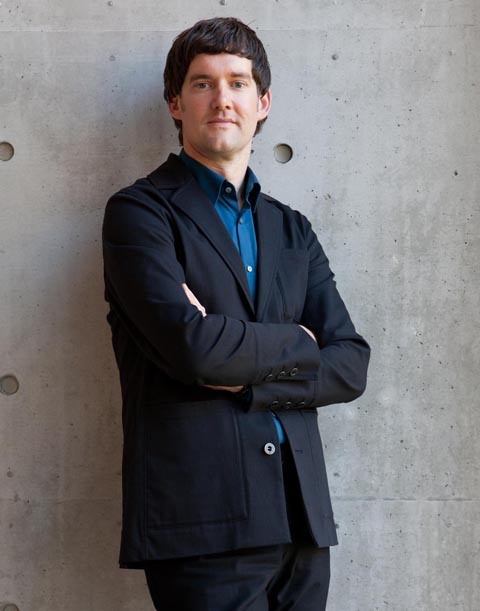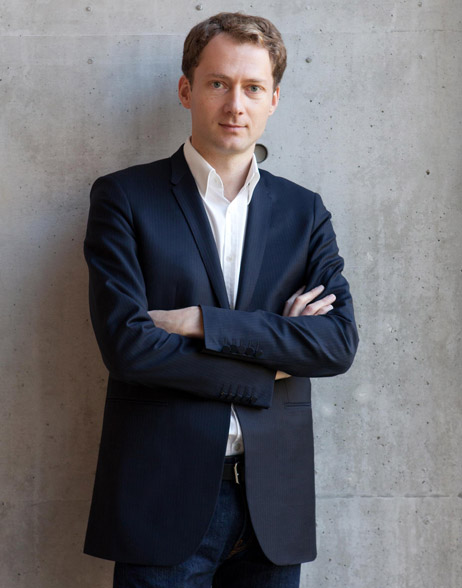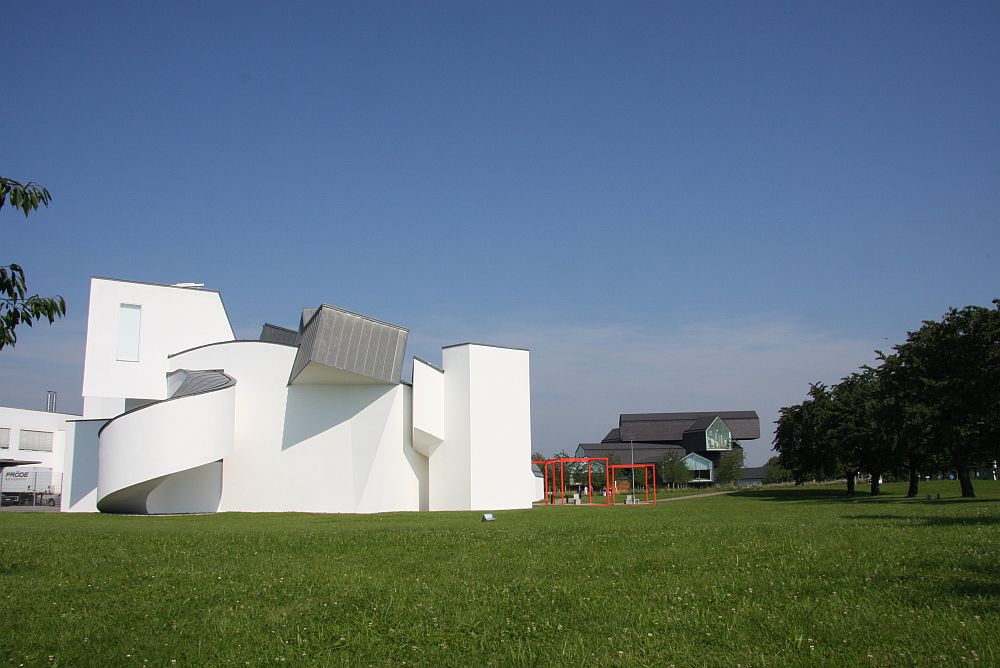Interview | Producer | Vitra | Weil am Rhein
Ostensibly established as a location for presenting and archiving Vitra CEO Rolf Fehlbaum's private collection of designer furniture, the Vitra Design Museum has developed into one of Europe's most important centres for design, design history but for all, for explaining design and making design accessible.
A large part of the museum's success can be credited to founding Director Alexander von Vegesack who led the institution from its opening in 1989 until the end of 2010.
In January 2011 Marc Zehntner and Mateo Kries took over the reins as a joint management team; Marc Zehntner responsible for the management of the museum, Mateo Kries for the programme.
Shortly after the first anniversary of their succession we caught up with Marc Zehntner and Mateo Kries and before we got round to asking how/if the dual leadership was working, started by asking them if the opening of the VitraHaus had had any noticeable effect on visitor numbers in the Design Museum?

Marc Zehntner: We had no real idea how things would be and so in advance we worked through various scenarios; less visitors, same level and more visitors. And at the moment we can say numbers are steady, tending to positive. It is of course strongly dependent on what we are showing, but in principle there are two distinct types of visitor. Those who come specifically to visit the Design Museum, and who then may go into the Vitrahaus, and then those who come specifically to visit the Vitrahaus, and we can motivate some of them to then come and visit us. But it's not the case that all Vitrahaus visitors come to us; which given the size of the museum is good, because we wouldn't have room for them all....
(smow)blog: In that sense was part of the thinking with the "new" Vitra Design Museum Gallery, that you could maybe attract more Vitrahaus visitor with smaller, less intense exhibitions?
Marc Zehntner:That was something that we calculated in the planning, but the real thinking was to be able to offer a wider range of events, also during the transfer phases between exhibitions when the main museum building is closed. With the gallery we can now offer visitors an exhibition every day, except for the three days in the year when we are closed. And that wasn't the case before.
Mateo Kries: Another idea behind the gallery was the museum is in good health, is running well, but the question was how can we grow. And that needn't just mean more exhibitions in the Gehry building. With the gallery we have the opportunity to organise exhibitions and events at relatively short notice and so offer exhibitions that are maybe more current than is normally the case. In the main museum we have a preparation time of around two years for a new exhibition. In contrast the planning for both the recent Jerszy Seymour event or the current Bouroullec exhibition started last summer.
(smow)blog: And so in general how long do you need for the gallery exhibitions, is it a matter of weeks, or months or...
Marc Zehntner:At least a couple of months, but it obviously depends on what we are doing. If we take something like the Jerszy Seymour action, that was something new that hadn't been done before, which is a different scenario from an exhibition primarily featuring items from our collection which again is different from something such as Album, which is an existing exhibition that needed to be adapted for our space.
Mateo Kries: For example, while the Bouroullecs was a relatively short run-up, during Art Basel we'll have an exhibition featuring 6 Dutch designers which, in relation to the size of the gallery, is a much more complicated and intensive project that takes a little more time to compile. But we want keep the preparation times as short as possible because we want to be able to offer more up to date shows.
(smow)blog: In addition to the exhibitions here, you also have the travelling exhibitions. How important are the travelling exhibitions, firstly financially and secondly in terms of marketing and advertising the Vitra Design Museum?
Marc Zehntner: Centrally important. The touring exhibitions have always been part of the museum’s concept, the founding director Alexander von Vegesack developed the idea and while today many museums do such, back then it was more the exception than the rule. That the Vitra Design Museum is so globally known and recognised is largely due to the travelling exhibitions. And from the financial perspective it's almost impossible to make a profit from an exhibition, but with the travelling shows we can, in the ideal case, break even.
(smow)blog: How many exhibitions do you currently have "on tour"
Marc Zehntner: At the moment it is 12. Last year we had 19 openings globally, not including those here in Weil am Rhein.

(smow)blog: One of the more interesting sources of income for the Museum is the miniatures collection. A collection that has grown steadily over the past 20 years. Who decides which models will be newly added, or what criteria do you apply?
Marc Zehntner: That is initially a team process involving the curators and those team members who look after the collection, but also, for example, the marketing department. And so first we compile a tentative list - what would we ideally like? What makes sense, especially in context of a forthcoming exhibition, for example we brought out an anthroposophic chair last year on account of the Steiner exhibition. The final decision to produce a miniature however is always "Can we produce the miniature close enough to the original and achieve our quality standards?" And many of our wishes go unfulfilled because they can't be realised, or at least not to a price that is realistic.....
(smow)blog:....and in that context is it correct that you also pay license fees for the miniatures just as with real chairs?
Marc Zehntner: Yes, which can also be further reason why a miniature doesn't make it onto the market. But that is less often the case, normally we reach an amicable agreement with the license holder.
Mateo Kries: But not just the license fees are analogous to the "real world", everything is exactly the same as with normal product development. We often need to develop special machines or tools, for example, to create the wicker work or moulds etc. Just the same as with full size objects.
Marc Zehntner: And when we're fairly certain that something will be produced then come prototypes that are tested, inspected etc and so it is essentially the same process.
(smow)blog: Which we presume also means just as with a real chair you can invest months in model and prototype building; and at the end of the day have nothing to show for it?
Mateo Kries: Yes, that happens often. We've a long, long list of products that either didn't work or didn't meet our quality standards.
(smow)blog: To finish, for the past year you’ve shared the management of the Vitra Design Museum. Is that working, or ...?
Marc Zehntner: Clearly the double leadership is a test, and even though the plan had been worked out and refined over a number of years before we took on the jobs, no-one could say for certain how it would develop. But it’s working out very well and we’re both very happy with the situation. And the museum itself is also developing steadily and currently finances itself to a great proportion, which is unusual in the museum world. We have a good, motivated team, interesting projects and so we can look very positively into the future.
(smow)blog: So no risk of the ideas running out?
Mateo Kries: The problem is more that we have too many possibilities! For the next three or four years we have so many options our biggest problem will be realising everything we want to. But it is fantastic position to be in. And even though we took on the museum in a very good position, we feel we've brought it on and are bringing in positive, new ideas. In the spring, for example, we will relaunch the website, which will include the first online impressions of the collection, plus we currently have a discussion or similar event here every couple of weeks and we notice that the public are responding very positively to the new fuller, livelier programmes. These are obviously all small steps, but together they will see the museum change and evolve as institution and see it become a much more vibrant location that doesn't just present exhibitions exploring the most important design themes and topics but much more asks question of the visitors and so becomes more of an experience.
Marc Zehntner: And ultimately it’s the same for any museum that really uses its collection; there are enough stories we must just pick out those stories we want to tell. And that's what makes the work so special.
